Restoring Historical Roofs In Canada With Long-Lasting Metal Products
By Erika Huber
Ornametals Manufacturing, LLC
Historical buildings are central to the character and culture of Canada. Safeguarded at the federal, provincial and municipal levels, historical sites are granted special designations that dictate the manner in which they must be preserved and restored. In addition to the strong mandates of official heritage conservation, owners and interested parties often have a strong desire to preserve the historical integrity of buildings – both architecturally and aesthetically. Unfortunately, owners and other interested parties have conflicting contemporary needs for economical solutions, in addition to the need to use building materials that are sustainable, durable and now, "green". Often, there is a conflict between the desire to preserve and the desire to provide for the future of the building.
Historical Case Study In Copper | |
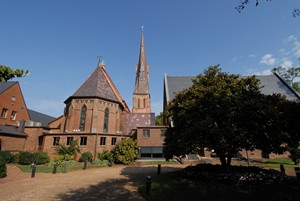 | |
The Episcopal Church of Nativity, Huntsville, Alabama, USA, was built in the Gothic Revival style in 1859. One-hundred and fifty years later, the Church was faced with a deteriorating roof that threatened to damage the historical building. Efforts to determine the original roofing material specified by renowned architect Frank Wills were made, but little or no documentation was found. In addition, several intervening repairs masked the original materials and application. Working within U.S. historical preservation guidelines, which are similar to those in Canada, the Church was able to support the installation of a new copper rauten tile roof. Both the choice of metal, and the installation practice (rauten tile) were deemed acceptable alternatives to the suspected original (stamped terne metal) because the modern solution matched as closely as possible the scale, texture and coloration of the historic roofing material. Photos of this project are shown throughout this article. (click image to enlarge) |  |
This conflict presents itself when specifiers need to choose roofing materials for historical buildings. Because of their prominence in a building structure, roofs are central to a building’s architectural character. On a practical level, of course, roofs are also essential to the protection of a building. A well-designed and installed roof will protect a historical building and preserve it for decades. In contrast, misguided choices in roofing materials and applications will accelerate a building’s deterioration.
When choosing replacement materials and applications, contemporary thinking leads specifiers to architectural metal for historical roofing - usually copper or galvanized zinc - because they are inherently sustainable, durable and "green". Problems arise, however, when copper or zinc were not used on the original structure, but using original materials is either environmentally undesirable, impractical (as in outdated installation methods or materials such as tin-plated or terne metal), or not suitable for future preservation (due to high maintenance costs of the original application, for example).
When approaching the restoration or preservation of a historical structure, it is useful to follow The Standards and Guidelines for the Conservation of Historic Places, which is a pan-Canadian set of conservation principles and guidelines. While The Standards provide specific guidelines for rehabilitation and restoration, they also outline a decision-making process that can help specifiers successfully specify roofing materials and applications different from the original.
 | Right: The restored steeple, and the original sanctuary roof.
Below: A view from the back of the Church, contrasting new and old. Although copper was not originally used, the owners wanted a historically correct solution for restoration that would be sustainable, durable and low-maintenance.
(click images to enlarge) |  |
| | 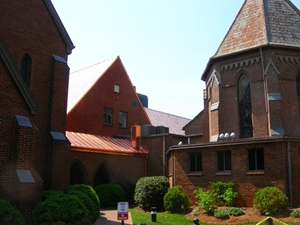 |
The first stage in the process is to understand the historical place, which in part means to understand a structure’s heritage value. Heritage value consists not only of a building’s cultural, aesthetic and historical importance, but also its character-defining elements, forms, location, spatial configurations, uses and cultural associations or meanings. A modern sensitivity to conservation inspires and instructs interested parties to understand the original roofing material and application in order to preserve the historical integrity of the original structure. Research into the roof’s history is an important and necessary element of this process. Sometimes documentation and photographs exist, but more often a physical inspection of the roof is necessary. While wood, slate and tile were all used in historical buildings, tin-plate iron, or “tin roofing” was used extensively in Canada in the 18th century. Often, however, research on a historical building will be inconclusive, meaning that specifiers must rely on the history of buildings in the area in general, for example, or must specify solutions that mimic, but cannot re-create, the original roof material and application.
Specifiers who want to use an alternative to historical metal roofing materials often choose copper, which may or may not mimic the aesthetic of the original, or galvanized zinc (which is closer to the look of tin-plated iron or terne metal, for example). In doing so, it is important to align the new application with the second stage in the decision-making process, which is to review the general standards for preservation, rehabilitation and restoration set forth in The Standards. Focusing on preserving the “character defining elements” of a structure, the general standards are helpful to a roofing specifier.
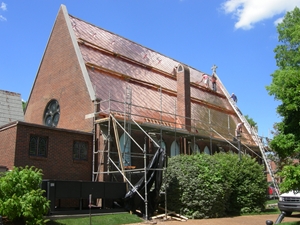 | |
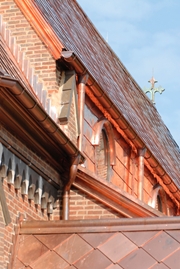 |  | Above: Workers install Rauten (interlocking) copper tiles on Bibb Chapel, Church of Nativity, Episcopal.
Left: Many different copper applications were successfully specified on this historical church, replacing stamped terne metal shingles.
(click images to enlarge) |  |
As already discussed, due to the prominence of a roof to a structure, and due to the important role roofing plays in the future integrity of a structure, roofs are often “character defining elements.” Therefore, it will be important when choosing alternative roofing materials to stress alignment with the building’s original character by specifying alternative materials that match as closely as possible the scale, texture and coloration of the historic roofing material.
Another important element of meeting The Standards is to plan for appropriate and sustainable use. In the case of historical metal roofing, future maintenance of the roof will be a major issue in determining whether or not to use alternative materials. Most historical roofs have been replaced several times, and will be replaced in the future. Therefore, preservation of “character defining elements” must be weighed against the sustainability and durability of the roofing material and application, which play a big role in future maintenance and repair costs. In specifying new materials or applications, it may be important to communicate that the search for alternative roofing materials is not a new problem. Throughout the history of the building, for example, it may have been necessary to make changes to the original structure in order to properly preserve the heritage value of the structure and ensure its future.
Copper was chosen, for example, for the restoration of Toronto’s Old City Hall in the early 1990’s. The original roof was clay-tile, replaced in the early 1920’s with a light gauge copper in order to reduce maintenance costs. While the light-gauge copper was much different than the clay-tile, the copper application was consistent with the building’s original character, and greatly improved the building’s viability by reducing maintenance costs. The modern restoration continued the historical use of copper, but at a heavier gauge to extend the roof’s longevity. The high cost of historical restoration makes the longevity of a roof an important factor in choosing new roofing material. In North America, there are many structures that feature copper that has been in place for over 200 years. In Europe, copper roofs have been in service for more than 300 or 400 years.
| | 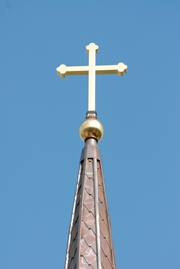 | | 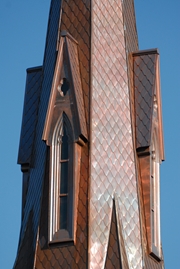 |
 | Above left: The 24-karat gold-plated cross, with ball, topping the historical steeple.
Above right: A major feature of the steeple are four dormer windows, custom-made to match the originals.
Right: Custom-crafted in copper, the specialized architectural details like this eyebrow window are exact replicas of the original.
Below left: Rauten (interlocking) tiles were chosen to preserve the building's historical integrity and protect it for the next 100 years.
Below right: Choosing craftsmen who understand quality installation is key, as shown in the crafting of the step flashing.
(click images to enlarge) |  | 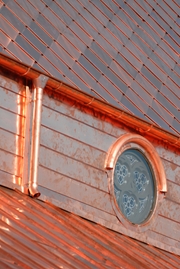 |
| |  | | 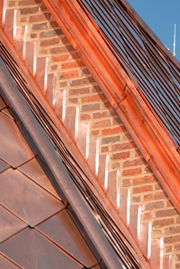 |
High maintenance costs related to tin roofing, for example, do not make it a wise choice for modern preservation efforts. Tin roofing deteriorates when the coating deteriorates and the iron rusts. Historically, undercoating of tin roofing – which may delay deterioration – was not used, and the surfaces may not have been consistently re-painted. The most obvious choices for maintenance-free metal applications are copper and zinc. Due to their durability and sustainability, copper and zinc are excellent investments in the past and the future. Their value is realized by their longevity.
In addition to the material, it is important to be able to preserve the historical integrity of buildings through the use of similar installation techniques and craft practices (standing seam, rauten tile, replacement of dormers and decorative elements). This is particularly challenging because the parties have to preserve the history while implementing more contemporary installation techniques. Historical craft practices may be too expensive to follow or have been superseded by modern improvements. In this regard, it is important to find modern craftsmen capable of reproducing historic details.
By carefully weighing the interests of all parties, and by following the decision-making process of The Standards, specifiers can be successful in employing new and different roofing materials and applications to historic buildings. The key is to emphasize a compromise between the past and the future by finding a solution that values a structure’s history while ensuring its place in Canada’s cultural landscape for years and years to come.
About Copper
Copper enjoys a long history in world culture, due to its aesthetic appeal and durability. Alchemists associated copper’s beautiful red-gold metal with Venus in part because the first mirrors were made from this material. During excavations in Egypt, 5000 year old copper mines were found - still operational. Together with gold, silver and tin, it was one of the first metals to be worked by humanity about 9000 years ago. Ships built in the 15th century were covered in copper plates to protect them from algae infestation. Today, copper is the metal of choice for many historical restoration and preservation projects throughout North America.
About VMZinc
For installations in which a visible weathering process is not desired - as in many historical restorations - pre-weathered zinc (QUARTZ-Zinc) is an ideal choice. When QUARTZ-Zinc combines with air and moisture, a matte blue-gray to blue-green surface is created, which mimics the historical application of terne metal. The material obtains a unique glow that is particularly well-suited for historic buildings.
Sources: Sweetser, Sarah M, “ Preservation Brief: Roofing for Historic Buildings,” National Park Service, U.S. Department of the Interior; and Standards and Guidelines for the Conservation of Historic Places in Canada, 2nd edition.
About Ornametals
 Ornametals manufactures rainwater products. For more information, visit www.ornametals.com.
Ornametals manufactures rainwater products. For more information, visit www.ornametals.com.